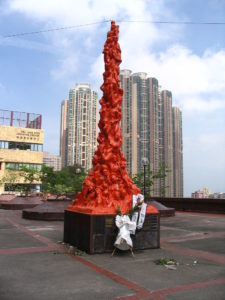Another one about statue-removal, though this one isn’t exactly good news. The Pillar of Shame is the name given to a haunting 26-foot-tall column of screaming faces, made primarily of copper and bronze. It is meant to commemorate the lives lost during the Tiananmen Square massacre, where hundreds or possibly thousands of pro-democracy protesters were slaughtered by the Chinese government on June 4, 1989. Until very recently, the Pillar of Shame stood on the campus of the University of Hong Kong. But around midnight on December 23rd, the statue was taken down, constituting another sign that the central government in Beijing is trying its hardest to assert control over Hong Kong. The university council announced that it had taken down the statue, and that it would be kept in storage for the time being. John Burns, a former HKU professor, commented that removing the Pillar of Shame “moves HKU and Hong Kong closer to the official state of amnesia about Tiananmen.”
This was not the only artwork removed from public view in Hong Kong recently. Both the Chinese University of Hong Kong (CUHK) and Lingnan University displayed replicas of the Goddess of Democracy, a statue created by the original Tiananmen protesters. The replica on CUHK’s campus was erected in 2008, but was also removed around the same time as the Pillar of Shame. The artist who created the Pillar of Shame, Jens Galschiøt, has expressed his intent to display it elsewhere to keep alive the memory of those lost at Tiananmen. Erecting it in front of the Chinese embassy in Washington DC was brought up as a possibility.
Given that Hong Kong is a semi-autonomous territory under the control of China, it is the only place within Beijing’s jurisdiction where an annual vigil commemorating the Tiananmen Square massacre is observed. In recent years, authorities have cracked down on remembrance events citing national security laws and now Covid-19 restrictions to do so. Many have commented that the actions of the Chinese government and the university council may have the opposite outcome than what was intended. In the destruction of the original Goddess of Democracy statue, the Chinese government accidentally ensured that it became a symbol of resistance, recreated in countless cities across the world on the anniversary of the massacre. So now the same may happen to the Pillar of Shame. It’s just human nature; the more you tell someone that something cannot be seen, the more they will want to see it.

